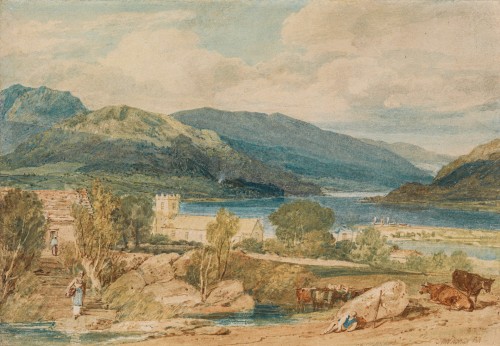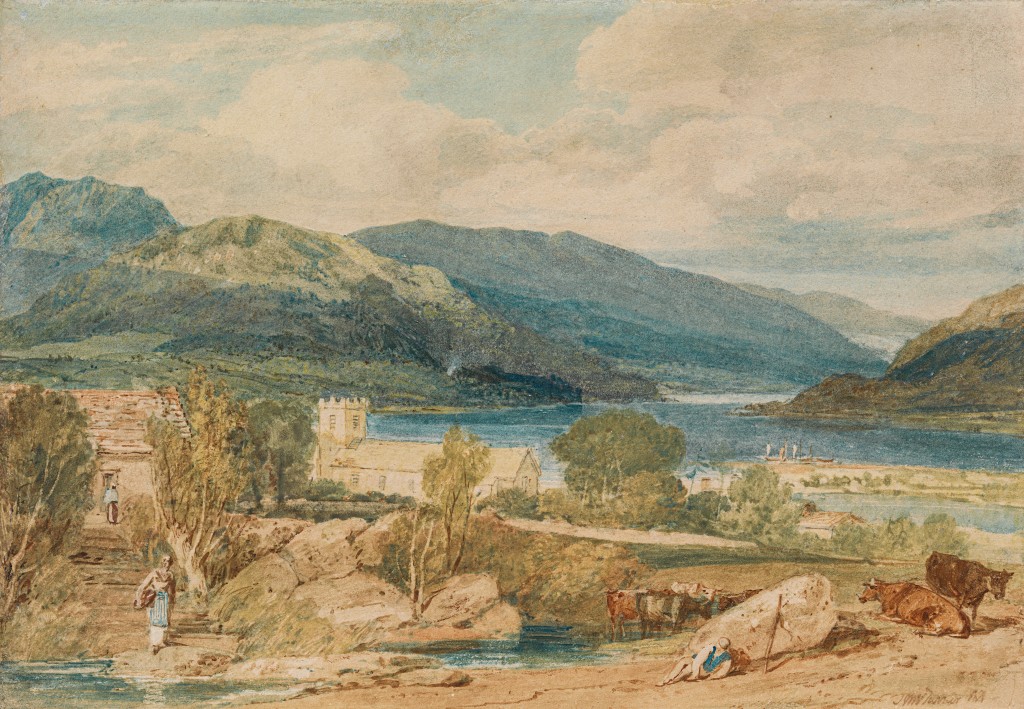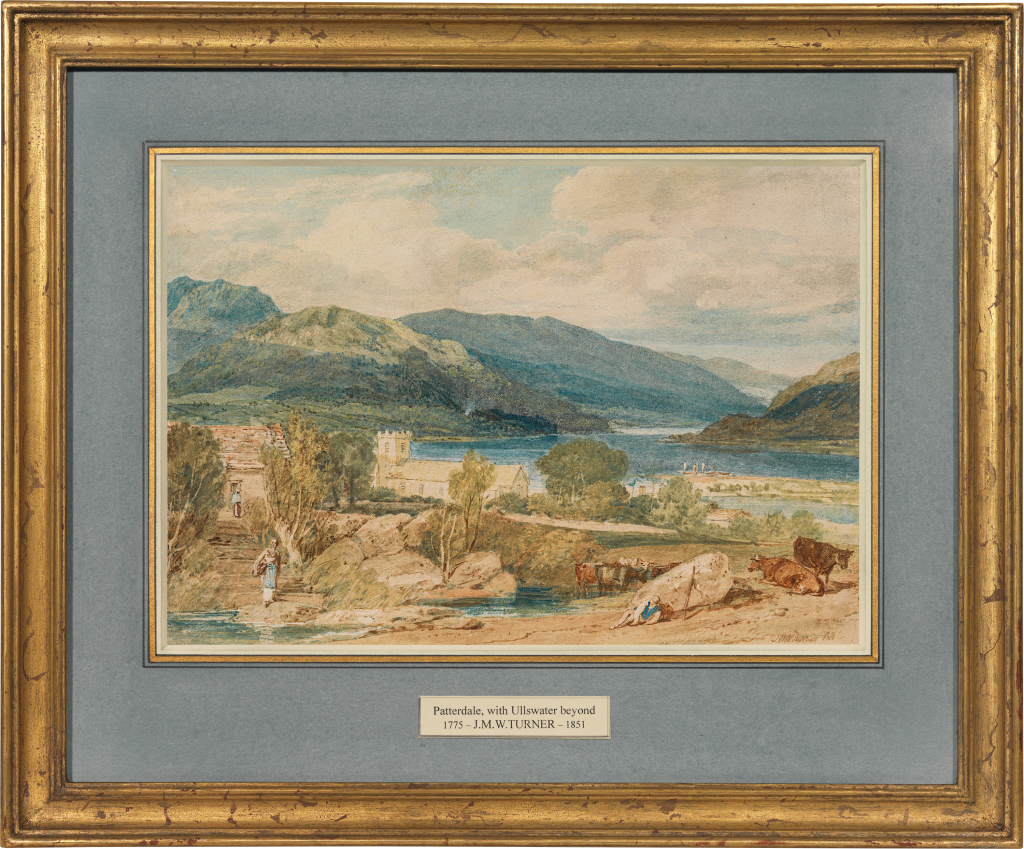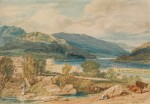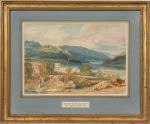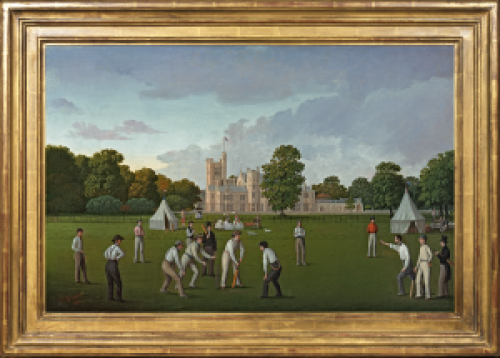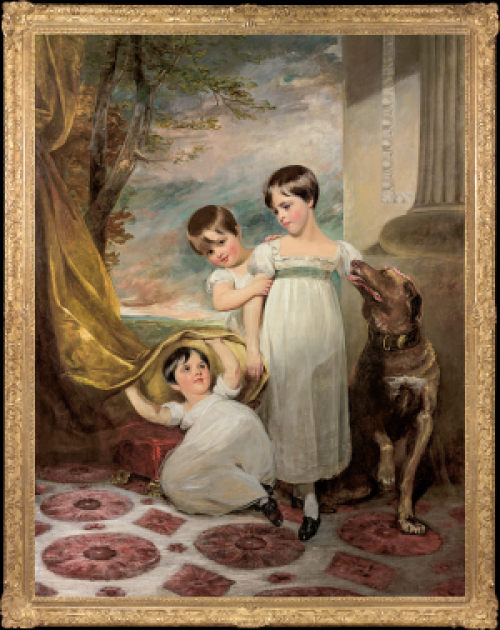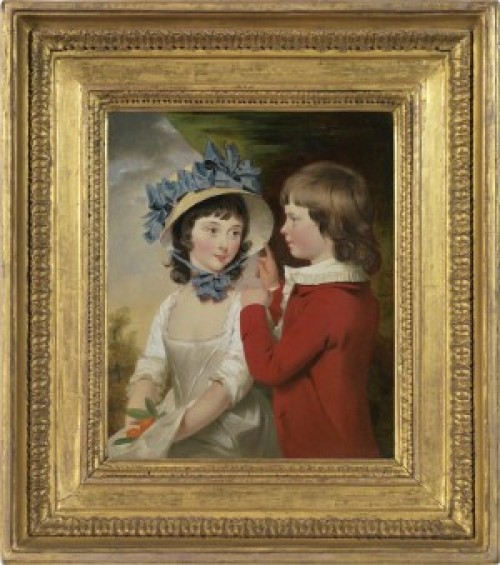JOSEPH MALLORD WILLIAM TURNER
1775 - London - 1851
Ref: CC 104
Patterdale, with Ullswater beyond
Signed lower right: J.M.W. Turner RA
Watercolour over pencil, heightened with brown ink and stopping out: 8 1/8 x 11 5/8 in / 20.6 x 29.5 cm
Frame size:
Painted circa 1804
Engraved:
By James Heath (1757-1834) for Joseph Mawman’s An Excursion to the Highlands of Scotland and the English Lakes, 1st May 1805 (Rawlinson 75)
Provenance:
Commissioned by Joseph Mawman for 7 guineas
Henry Bradley (1802-1870), of Leamington;
his sale, Christie’s London, 26th May 1860, lot 36 (as An English Lake Scene, with a church, and cattle in a pool of water, £80 to Rought)
Joseph Gillott (1799-1872), of Birmingham;
by descent to his son, Joseph Gillott (d.1904) of Berry Hall, Solihull, Warwickshire;
his executor’s sale, Christie’s London, 30th April 1904, lot 24 (as River, Church, Figures, and Cattle, £147 to Wallis)
Scott & Fowles, London
Patrick A Valentine (1861-1916), of Chicago;
by descent to his wife, Mary Lester Armour Valentine (d.1965)
her sale, Parke-Bernet, New York, 18th April 1962, lot 67, (as Scene in the Lake District; bt jointly by Newhouse Galleries, New York & Agnew’s, London (stock number J2427, Patterdale);
by whom sold on 23rd May 1962 to JG Pilcher
by descent in the family trust to a private collection, UK
Exhibited:
London, Agnew’s, Turner Watercolours, 1994, no.4
London, Tate Gallery and Leeds, Harewood House, Turner in the North of England, 1996-7, no.66
Literature:
Joseph Mawman, An Excursion to the Highlands of Scotland and the English Lakes, London 1805, pp.209-10
Walter Thornbury, The Life of JMW Turner, Founded on Letters and Papers furnished by His Friends and Fellow Academicians, London 1862, vol. II, p.407, as English Lake Scene, with a church and cattle in a pool of water; and revised edition of 1877, p.608
WG Rawlinson, The Engraved Works of .MW Turner, vol. I, London 1908, p.32, no.75 (as untraced)
AJ Finberg, A Complete Inventory of the Drawings of the Turner Bequest, London 1909, vol. I, p.153
Andrew Wilton, The Life and Work of JMW Turner, Fribourg 1979, p.325, no.229 (as untraced)
Edward Yardley, ‘Picture Notes’, Turner Studies, vol. 5, no.2, 1985, pp.54-6, illus.
David Hill, Turner in the North. A Tour through Derbyshire, Yorkshire, Durham, Northumberland, the Scottish Borders, the Lake District, Lancashire and Lincolnshire in the Year 1797, New Haven and London, 1996, pp.124, 126 & fig.182 (as Ullswater, Patterdale Old Church, looking north to the lake, c.1802) and 194
Cecilia Powell and Stephen Hebron, Savage Grandeur and Noblest Thoughts. Discovering the Lake District 1750-1820, exh. cat., Wordsworth Museum, Grasmere, 2010, pp.99-102, fig. 28
Martina Padberg, Joseph Mallord William Turner, Konemann 2017, p.107
The village of Patterdale lies at the southern end of Ullswater, the second largest stretch of water in the English Lake District. For those not wanting to travel via Keswick, the road from Patterdale up over the Kirkstone Pass provides an alternative route from the north-east into the heart of the National Park area between Ambleside and Windermere.
Turner first toured the lakes in 1797, at the age of twenty-two, at a time when the region had already been established as a place of Picturesque and Sublime appeal by artists of the previous generation, such as William Gilpin, Thomas Gainsborough and Joseph Wright of Derby. Although evolved in the second half of the eighteenth century, these two aesthetic approaches continued to dominate landscape ideas well into the nineteenth century. Turner famously embraced the visual drama of scenes of impending catastrophe or thunderstorm, especially in his oil paintings. But he was just as proficient at capturing the charm of the quieter pastoral landscapes he encountered, as in this watercolour.
By 1797 guidebooks were available to steer the visitor to various spots that had become established viewing ‘stations’. Inevitably Turner’s instincts took him to some of these, but at such a young age his natural inclination was to strike out and find his own way of framing the landscape. When surveying Ullswater he noted Patterdale’s relationship to the towering slopes of Helvellyn above it in a watercolour now in the Fitzwilliam Museum.[1] He also made a pencil sketch of the view looking north over the lake from slightly above the village, which provided the basis for this work. Like nearly all of his Lake District subjects, the drawing was recorded in his ‘Tweed and Lakes’ sketchbook, which is now part of the Turner Bequest at Tate Britain (fig.1).[2] Even in its perfunctory outline, there is a sense of its pictorial potential, with the composition skilfully nestling the church and other buildings among the surrounding hills. Indeed, after returning to London, the sketch caught the attention of a ‘Mr Mason’ when Turner was showing the book to people who might commission watercolours; accordingly his name was annotated on the verso of the sheet.
But it was not until 1804 that Turner went back to the sketchbook in order to develop his record of the setting at Patterdale. That year Joseph Mawman (1759-1827), the editor of the Critical Review, made a tour of some of the same parts of northern England that Turner had visited seven years earlier, as well as venturing across the border into Scotland. Drawing on his experiences, he compiled the text which was eventually published as An Excursion to the Highlands of Scotland and the English Lakes (1805). Evidently aware of the commercial advantage that Turner’s images had bestowed on other publications, he approached the artist to seek a group of watercolours that could be engraved as illustrations.
The essence of the commission is recorded on a sheet in the Turner Bequest relating to Turner’s own tour of Scotland in 1801, when he travelled across from Edinburgh up to Pitlochry and the Trossachs, as well as exploring the western route between Inverary and Glasgow.[3] Both men were apparently enchanted with Inverary, and it was agreed that two of the watercolours would focus on the Castle and the Town. Ultimately, however, only the view of the town was completed.[4] Another Scottish subject selected was a view of Loch Lomond from the Point of Firkin, which has been in many of the same collections as this view of Patterdale during its history (fig.3).[5]
The most striking and curious decision about the choice of images for Mawman’s book was that, despite the implication in its title that the Lake District would receive equal attention, just one scene was selected to represent the whole area: Patterdale. This suggests that both Turner and Mawman believed the image could work on an emblematic level, as well as on its intrinsic merits. In working up the design Turner gave greater prominence to the human element, replacing the figures working in the field in the sketch with a herdsman resting among his cows while a statuesque young woman approaches the stream to do her washing. Mawman had praised the ‘impressive beauty’ of the Lakeland women he saw on his journey, noting they ‘walked gracefully’ and that ‘all had an air of superiority which sat easy upon them’.[6]
According to the note in the Turner Bequest, the agreed rate for each of the four watercolours was seven guineas. The list is further annotated with an update to reflect that only 20 guineas was eventually paid for the three designs that were finished and delivered.
Mawman’s costs would almost certainly have been double this again for enlisting the engraver James Heath to translate the watercolours into black and white intaglio prints. Working from Turner’s images was invariably a challenge, but Heath (then approaching sixty years of age) proved in his version of Patterdale he was more than competent, recreating the tonal variations that suggest colour and aerial perspective, while also introducing or exaggerating Turner’s own highlights for added variety across the image (fig.2). Compare, for example, in both works the smoke rising on the hillside directly above the church, or the cluster of sails at the lake’s edge.
In his text, Mawman made a direct connection between his own description of the view over Ullswater and Turner’s depiction: ‘In our rambles about Patterdale from a rising ground behind the village we caught a beautiful view of the lake (as represented in the annexed plate) with the interesting fore-ground of a quiet and romantic group of cottages scattered round the church, and the fine woods of Gowbarrow, contrasted with the gigantic and naked precipices of place-fell on the opposite side of the water, in the distance’. More recently, David Hill has noted that access to the same spot is no longer possible: ‘The scene today is only recognisable with difficulty, the church having been completely rebuilt [in the 1850s] and sight of the lake denied by tree growth and lack of public access. We can see, however, that Turner follows the line of the hills carefully, and creates an effect of late afternoon light, setting the sun low to the west so that long shadows rake across the fellsides, cast by unseen high hills out of the composition to the left’.[7]
Turner did not always sign or date his works but here he has added his name in the right-hand foreground, in exactly the same spot that he inscribed ‘Patterdale’ in the pencil sketch. In doing so he perhaps sought to further anchor the image in this corner. He had already enlarged the rock against which the cowman leans, and which playfully echoes the shape of the sitting cattle. By adding the letters ‘R.A.’ to his own name he was asserting his relatively recent admittance as a notably young member of the Royal Academy in February 1802.
Once the watercolour had been engraved for Mawman it is not known how long it remained with him. It is next documented in the collection of Henry Bradley of Leamington, who was a magistrate noted for his patronage of the arts. The watercolour was afterwards acquired at his sale in 1860 by Joseph Gillott, a Birmingham manufacturer, who compiled one of the finest collections of Turner’s works in the 1850s and 60s, beginning with the purchase of eight oil paintings priced at £500 each in 1844.[8] When the Patterdale watercolour eventually left the Gillott family in 1904 it reached £147, a sum far exceeding the £52.10 shillings for the companion view of Loch Lomond, also painted for the Mawman publication (fig.3).
Ian Warrell
NOTES
1 Andrew Wilton, The Life and Work of JMW Turner, Fribourg 1979, p.325, no.228; see Hill 1996, op.cit., p.126, fig. 183.
2 Turner Bequest XXXV 44; D01046, Tate.
3 AJ Finberg, A Complete Inventory of the Drawings of the Turner Bequest, London 1909, I, p.153; see the discussion of this in Yardley 1985.
4 Wilton 1979, p.340, no.352; Manchester City Art Gallery.
5 Ibid., no.353; Sotheby’s, New York, 31st January 2024, lot 188.
6 Quoted in Powell and Hebron 2010, p.102.
7 Hill 1996, p.126.
8 See Jeannie Chapel, ‘The Turner Collector: Joseph Gillott, 1799-1872’, Turner Studies, vol.6, no.2, pp.43-50.
COMPARATIVE IMAGES
Fig.1
Patterdale Old Church, looking North to Ullswater, 1797
Pencil, 27.4 x 37 cm
Tate Britain (D01046; Turner Bequest XXXV 44)
Fig.2
James Heath after J.M.W. Turner
Patterdale, 1805
Line engraving, on cream wove paper, image size 10.5 x 15.2 cm (4 1/8 x 6 inches)
Yale Center for British Art, Paul Mellon Collection, New Haven
https://collections.britishart.yale.edu/catalog/tms:15803
Fig.3
Loch Lomond c.1804
Watercolour
c/o Sothebys 2024

